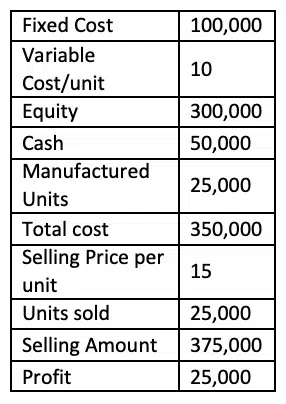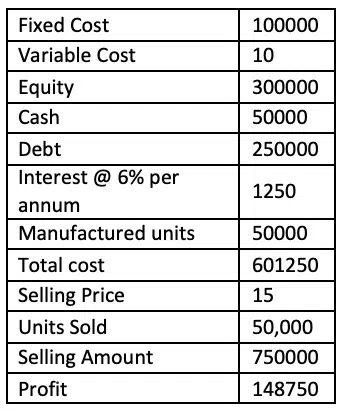Debt to Equity Ratio Calculator
Debt to Equity Ratio Calculator: Equity Stock Calculator and Formula.
Insert the total liabilities and the total equity of a company into this Debt to Equity Ratio Calculator to receive the Debt to Equity Ratio. These metrics can be found via a Google search, in the annual report on the company’s website under “Investors Relations” or on financial websites.
In our Premium Tools financial data is loaded automatically and the most important financial ratios are displayed for more than 45000 stocks worldwide.
What is the Debt to Equity Ratio?
The Debt to Equity Ratio or Indebtedness as it is often known is a financial metric that indicates the relative proportion of liabilities and shareholder equity in the company. It is a measure of the company’s leverage and in general only debt portion is considered in liabilities.
It is an important metric as it indicates how the company is financing its assets and operations. Both debt and equity have associated costs and limitations with cost of equity generally higher than the cost of debt.
This ratio, while simple in its expression, has a surprising amount of depth and complexity to it with different groups of people with different understanding of it either disparaging it or praising it to the moon. Let us delve into the ratio and its wide range of applications while wrapping our head around its complexity. Our debt to equity ratio calculator helps you to determine this important number.
Formula:
Debt to Equity Ratio: Total Liabilities / Total Shareholder Equity
Both of these can be found on the balance sheet. It is generally quoted in ratio form but can also be quoted in % form when you refer to it in terms of indebtedness. On fairvalue-calculator.com we refer to it as indebtedness as we find this ratio to be a representative of debt burden on the company and its shareholders.
The complexity in the ratio begins with what you consider under total liabilities. Shareholder equity is generally pretty straightforward as it comprises of equity plus reserves and surplus or retained earnings. Liabilities however are a whole different ball game. For any company, liabilities tend to differ from industry to industry. Some experts have declared that only debt is to be considered as liabilities for debt to equity. However it is not fair for companies where liabilities are as strong as debt but not concentrated in debt. For e.g. a steel manufacturing company may have high debt accrued to finance its plants and machinery.
However a services company may not have a high debt as it does not require a factory but it may have its liabilities concentrated in employee compensation programs like an employee pension plan. Debt too has a different nature when it comes to the duration for which the debt is taken.
Debt on company books are of two types: Long term debt taken to finance assets i.e. purchase land or buildings, setup plants, acquire machinery or licenses etc. and short term debt for working capital which is used to finance day to day operations and pay for raw material, wages and utilities etc. Short term debt tend to have low interest rates and are rolled over frequently and with ease.
Also short term debt is generally smaller in proportion and weightage than a long term debt which is often sizeable and has a high interest burden as well. Some proponents of debt to equity ratio prefer only long term debt whereas some prefer to account for both types. Finally there are liabilities on financial statements that are difficult to evaluate. Contingent liabilities as the name suggest are provisions made for contingency: Usually a lawsuit pending outcome. A favorable lawsuit will see that liability evaporate whereas an unfavorable one will see it materialize on the books. Considering them in a debt to equity ratio calculator will often lead to incorrect values.
Example:
Debt to Equity ratio is highly industry specific. Capital intensive or physical asset heavy industries like manufacturing tend to have higher D/E as compared to those that are less capital intensive or asset based for e.g. information technology. This has to be considered when using our debt to equity ration calculator.
On a standalone basis D/E can shed little information, however a very high number i.e. greater than 5 or a very low number i.e. less than 0.5 is a matter of concern and one which warrants further investigation. Some investors prefer their companies to be debt free. They want a debt to equity ratio to be 0 or as close to 0 as possible. These companies are successful and often tend to do well but that is not always the ideal case. See, debt adds an element of leverage to business operations.
A company seeking to grow needs to finance that growth. One can grow using only equity and internal cash accruals, however that may not always be enough. Debt helps fuel that growth. As long as the cost of debt is lesser than the earnings generated using that debt, the company will enjoy superior earnings as compared to its debt free peers. The problem begins when the intended growth does not materialize and the cost of the debt burden is not in line with the earnings growth. Let us try to understand this with a hypothetical example.
A company manufacturing any product has a fixed cost of € 100,000/- per month and a variable cost of €10 per unit of product that it manufactures. It sells each piece at €15. It has equity of €300,000/- and cash of €50,000/-. With this amount, one can calculate that it can manufacture 25,000 qty. of that product. It would make a profit of €25,000/- per month. Let’s visualize this in a table format for easier analysis.


Now with debt we have a monthly interest cost of €1,250. However we can now manufacture double the quantity and our cost per piece has reduced since our fixed cost of €100,000/- which was originally spread over 25,000 units has now been spread over 50,000 units. This has resulted in our profits almost tripling (i.e. 3x) our original profit. This is an example of how leverage can enhance earnings significantly.
Here the company anticipated a demand of additional units. Were this demand to not materialize, then the company would have incurred a loss. In the above example, if only 30,000 units were sold instead of 50,000, the company would have ended up making a loss of €-151,250/-. An ideal debt to equity ratio is 1. This means the value of debt on the books of the company is equal to the value of shareholder’s equity. This allows for sufficient leverage and at the same time ensures that the debt burden is manageable by internal earnings should an eventuality occur and the demand fails to materialize.
Let us look at how the debt to equity or indebtedness moves across various different sectors and their stock price performance. We shall compare those companies in their respective sectors across those which we have already covered in our other calculators.

Retail is a sector which tends to have high indebtedness but most of which it is focused on short term debt than long term debt. Retail stores tend to have high turnover of their inventory and they constantly require inflow of products from their suppliers.
Thus their liabilities tend to be high on the accounts payable side and their debt occurs from suppliers than financial institutions. Large Retail stores like the above also tend to have large properties on lease or self-owned which requires debt financing as well. Another industry or sector that has crazy high indebtedness includes banks and insurance companies. The business model of banks relies on borrowing at low rates (from depositors in the bank) and lending them at higher rates making the difference their profit.
Since their margins are razor thin, they have to take on high leverages and churn their assets in order to make a decent profit. The biggest peculiarity for banks is that their financial statements need to be read in reverse to traditional statements. For a traditional manufacturing company, the loans it takes become liabilities and the plant and machinery it acquires becomes their assets.
For a bank, the loans it gives out are their assets and the deposits they receive from their customers are their liabilities. While regulations vary from country to country, banks and insurance companies on typical have 10% of the money from equity and remaining 90% from debt maintaining an indebtedness of 900% or more. Let us look at the top insurance companies across the world to measure their indebtedness.


Soft drink is an industry where the demand is fairly estimated and does not change much across time periods. An average individual will consume a certain amount and is not going to suddenly start consuming more.
In fact, with the current obesity issue plaguing the developed nations in the world, consumption of carbonated beverages is on the decline. Taking leverage to expand production or effect growth does not make sense here unless it is being done to diversify away from these business. In fact, the interest costs arising out of that leverage eat into the margins and affect profits if the newly diversified businesses fail to take off. Finally let us have a look at some of the top companies in the word, their indebtedness and returns as we explore what makes each of them tick or not tick in their segment.

Apple is primarily into smartphone manufacturing and has a strong demand for its product. It needs debt to finance its growth and tap into new markets and makes sense for it to have a high debt to equity ratio. Amazon on the other hand is primarily into ecommerce and online retail.
It does not have the same requirements as physical retail stores that we saw earlier. Its primary cost is in warehousing which can be leased as well. With its primary role as a marketplace, a high debt to finance growth involves using that cash to give discounts and attract customers, which hits the bottom line and thus is viewed negatively. Google being a search engine requires no such cash to grow and thus its debt to equity is pretty low.
Finally Netflix has been borrowing greatly to create new and original content but the same has not been reflected in its subscription growth prompting the markets to rate the stock poorly.
What you should be looking for:
Ideal Debt to Equity ratio for most industries is 1 or near 1. That being said, a lot depends on the industry in question. A debt to equity nearing zero or moving very high as compared to others in the industry is a cause for concern. Companies with near zero indebtedness might be good and stable and strong but are not making efficient use of capital.
That is detrimental to you as an investor because of the cost of capital involved. Both equity and debt have a certain cost attached to it. The cost of debt is simply the interest paid. Cost of equity is slightly complicated. It is not an outright expense but more of an expectation on investment. An equity investor investing in a company is taking on a risk and would want the company it invests in to deliver returns higher than the average market returns.
This is known as risk premium. Cost of equity is roughly measured as the Risk Free Rate + Beta * Risk Premium with Risk Premium being the difference of market return and risk free rate. Risk free rate is the return generated by a treasury bond usually 10 year treasury bonds and beta is the measure of how the company share price moves in relation to the broad market.
Thus the cost of equity tends to be on the higher side than the cost of debt although it is not an outright expense. The cost of capital for the company then becomes the weighted sum of the costs of debt and equity. For a company to survive in business and make money for its investors, it must grow its earnings at a rate higher than the cost of capital.
A company not utilizing debt to explore present avenues of growth is doing injustice to its investors by not growing earnings greater than the cost of capital. Such behavior prompts investors to stay away from the company when it tries to raise money via equity in the future. The usual limitations of D/E ratio with terms of asset heavy industries and high debt leading to financial problems remain.
Ideally one must evaluate the industry level debt to equity ratio and then move to the company to see whether it is better or worse than the industry. Most importantly, there must be a reason to leverage or de-leverage and investors must verify if that reason is valid and whether the company is doing the right thing to make use of that opportunity.
Conclusion:
Indebtedness is a good measure to determine whether the company is using leverage for its advantage or is in over its head. It is also a good indicator of survival of the company during bad times as a company with high D/E will have a hard time servicing that debt when the economic cycle takes a downturn.
That being said, an industry comparison is a must as different industries operate on different terms and are influenced by different factors. Always remember that no single ratio is the holy grail of investment selection. One must build a consensus of various financial ratios like P/E, P/B, and ROE etc. alongside indebtedness in order to arrive at an investment decision. Alternatively, join our premium membership and we will do all of this work for you, providing you various fair values right on your very own premium dashboard. By using our premium services, you will not have to operate our tools like the debt to equity ratio calculator yourself but will receive the most important information first hand and automatically.
In my experience, a combination of short term and long term debt is to be considered for calculating debt to equity ratio. All other liabilities must be eliminated.
Also personally I consider market value of equity as the shareholder’s equity value instead of the book value from financial statement. Market value of equity is the market capitalization of the company i.e. total number of shares multiplied by the share price of the company. Take on an average a 20-30% discount on market capitalization as your total equity value.
The reason being that market capitalization is a closer representative of shareholder value than the book value in financial statement. When a company raises money via equity, it will do so at market price and not at book price in the balance sheet. The discount is to account for large equity sale in times of distress. In case a distress hits and the company has to issue equity to cover the debt, the share price will take a hit of 20-30% to account for that sale.
Once my liabilities are considered and equity discount is priced in, I will then compare this ratio of the company along with its competitors to determine how my company is placed. Then I will evaluate other ratios and build a consensus to determine my investment decision. Now you should be ready to use our unique debt to equity ratio calculator.
